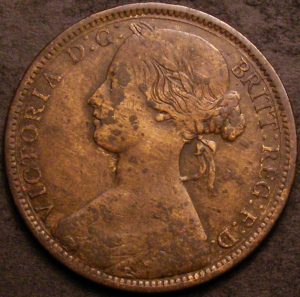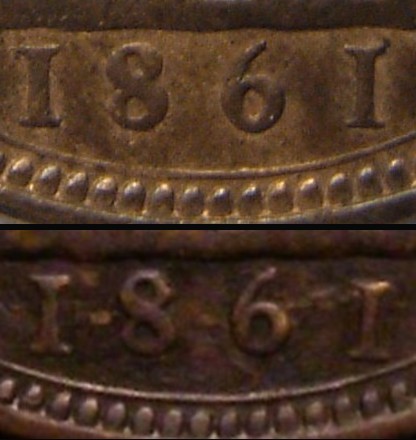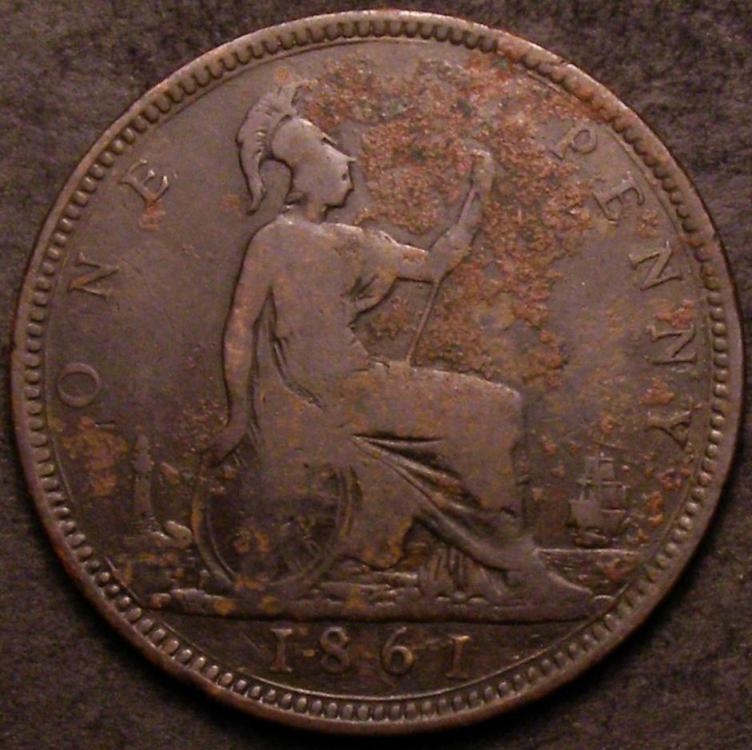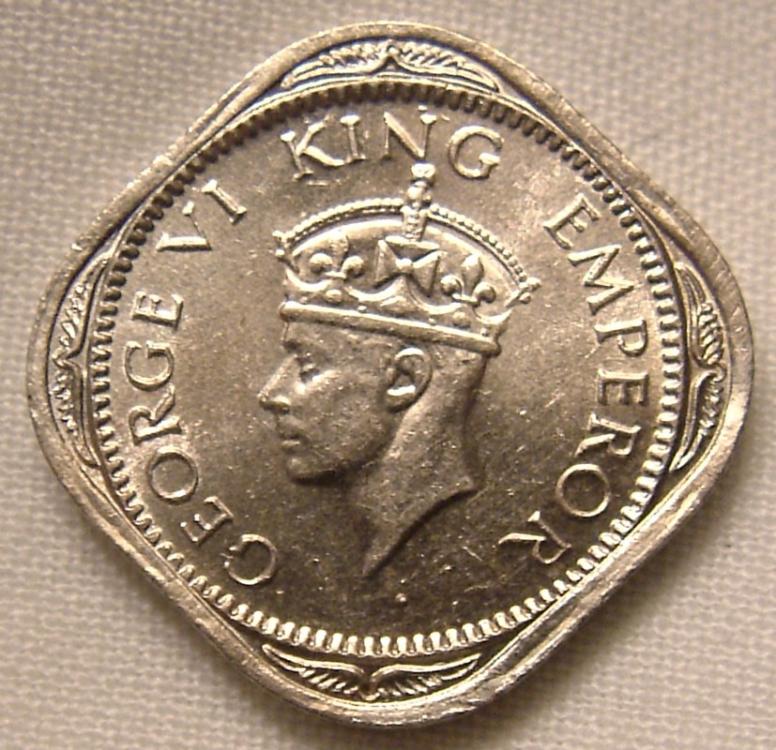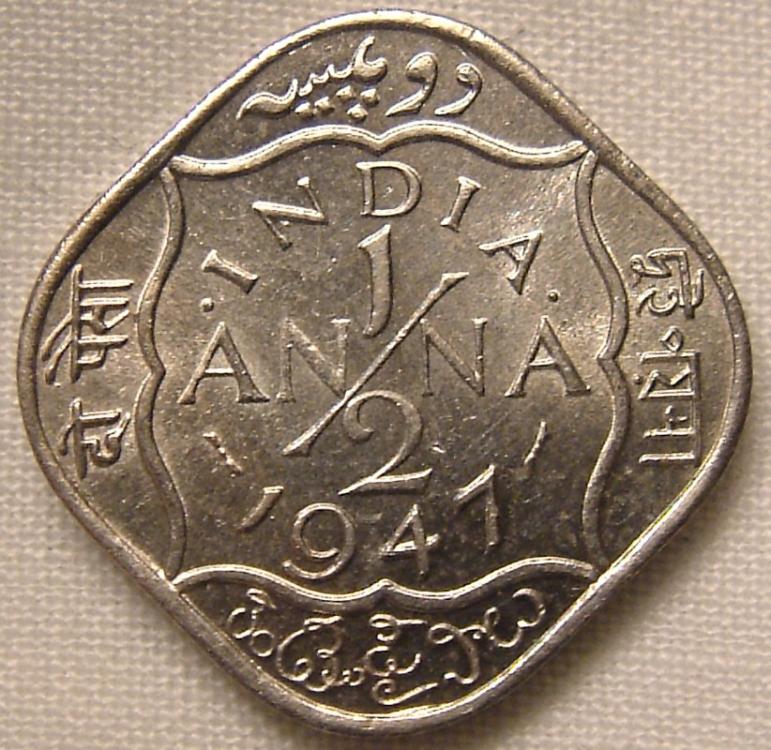-
Posts
786 -
Joined
-
Last visited
-
Days Won
84
Content Type
Profiles
Forums
Events
Downloads
Store
Gallery
Articles
Everything posted by alfnail
-
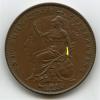
Penny Acquisition of the week
alfnail replied to Paulus's topic in British Coin Related Discussions & Enquiries
I wonder if any member has ever attempted to study differences in LC WYON locations. Perhaps we should all now be examining our own specimens to see if the W of LC WYON is ever seen anywhere other than under centre of the rose. -
Yes, the one on Richard's site as his example 9, also with a different date width to the usual F24's. Maybe we need to ask Bernie how many F24 die pairings!
-

Penny Acquisition of the week
alfnail replied to Paulus's topic in British Coin Related Discussions & Enquiries
I have seen similar marks under the bust on several early bun years, attached are two examples from 1861 and 1860. They seem to come in different thicknesses and pointedness (if that's a word!). My guess is that on my two examples this is reverse ghosting of the areas between the teeth. I am not sure this is what is going on with Richard's coin though; it almost looks as though the top half of a C (of LC WYON) is present on that Baldwin's coin. -
Thanks Mike I'm sure you are right, but you never know, I did sell my F24 and F27 when the "I need another holiday" pressure was on!
-
Probably one of the last pieces I will ever sell Mike, may even take that one with me to the grave...........although I have difficulty explaining that sort of thing to my wife!
-
Hi Mike, picture of obverse of that F32 Type 2 is attached as requested. It is not actually in my own collection, but can be seen on Richard's rarestpennies website as his example number 8. The only example of F32 which I have retained is the one also shown on his website as example 12. Despite the low definition obverse picture of example No. 8 I can now see the V to linear circle distances differ.................thanks to Bernie pointing this out.
-
...when I said 'pictured above' I meant on Page 96 of this thread!
-
Re. Bernie’s comment “two known die parings of F32”, I have only ever owned a couple of this rare type, so not studied in any detail, but my own findings do show two different reverse date types…………as pictured on the attachment. I think the top date is more common, and same as the ones pictured above, but the bottom date in my attachment has the last numeral one even more slanted than the commoner type. Full reverse picture also attached for reference. May I ask if it is this reverse ‘date variation’ which prompted the “two known die parings” comment, or whether there is some other feature which I have not yet observed? I have noticed that some of the commoner reverse date type develop a die flaw after the first N of PENNY (same as Jerry’s example, top one of the 3 pictured above), but also wonder if there is more than one obverse involved on an F32.
-

Penny Acquisition of the week
alfnail replied to Paulus's topic in British Coin Related Discussions & Enquiries
Think zookeperz has now covered much of what I have just typed, but here goes anyway! I believe this is a Gouby Date Style A http://www.michael-coins.co.uk/cp_1858.htm Pictures of one of my own examples attached; think exact same dies, noting the following:- · Same die flaw to front of truncation, looks to be a bit more developed on your piece · Same die flaw as your piece (highlighted with red arrows) around the T of VICTORIA · Not pictured, but my example also has an additional obverse flaw running through the base of the TIA of GRATIA, same as on your own coin · Same very close REG colon position, note G repaired · Same N’s of BRITANNIAR, particularly noting the clumsy 2nd N repair · Date has small additional piece to inner bottom loop of the 1st numeral 8 (again highlighted with arrow) · 8’s seem a little ‘pointed’ at top left of top loop (again highlighted), yours may have an additional mark which I think has suggested to Pete it may be an overdate……...which I don’t think it will be! Not a particularly rare variety in my opinion, colons on the Victorian copper penny series are all over the place! -
I'm not an expert on Indian coins, but I do have a collection of George VI World coins for the last year he appeared on every Country, and for all denominations. I have now completed this 'sideline' collection of 150 coins, trying to acquire as high a grade as possible. For India this meant finding a 1947 Half Anna from the Bombay mint, which at first sight (looking at supposed mintage figures) I thought would be a real doddle! I think I looked for two years before I found a low grade piece, which I let pass because I wanted UNC, perhaps in hindsight that was a mistake. Anyway, I did eventually find a nice example but unfortunately the seller also knew it was an extremely difficult type to locate, so I found myself paying the asking price rather than risk regretting letting it go and then never finding a decent one again. It was in fact the second most expensive piece in this small collection, more than the 1952 BWA Sixpence and almost as much as the 1952 Mint State Australian Sixpence. Pictures are attached for your reference, small dots on both reverse and obverse as I think you were expecting.
-

1908 Penny (take 2)
alfnail replied to Unwilling Numismatist's topic in British Coin Related Discussions & Enquiries
Nothing gets past you Terry Think I have experienced similar 'mixed up' pictures on ebay about half a dozen times over the years. If the listing had not been restricted to ebay.de then I think there could have been much competition over this one..........and a big price, and subsequent disappointment............caveat emptor!! -

1908 Penny (take 2)
alfnail replied to Unwilling Numismatist's topic in British Coin Related Discussions & Enquiries
Did anyone see this ebay listing:- https://www.ebay.co.uk/itm/Great-BRITAIN-ONE-PENNY-1908-/112878742292?_trksid=p2047675.l2557&ssPageName=STRK%3AMEBIDX%3AIT&nma=true&si=S7CDmUU14oM%252FkBzkbMKSWjTp4i4%253D&orig_cvip=true&rt=nc -

March 2018 LCA
alfnail replied to 1949threepence's topic in British Coin Related Discussions & Enquiries
Sounds like with all those exclamation marks and precise price that it must have been you Richard -
....with WW on the truncation?
-
Is it the inverted Panda variety
-
Think looks more like a repair to an underneath earlier O (at 140x mag).............rather than an N...............but I see it's already reached £261
-

Victoria Penny 1844 Double date
alfnail replied to interNumi's topic in British Coin Related Discussions & Enquiries
.....and the promised doubled date close up on this same coin. Colour differences due to digital microscope, but it is definitely same coin which you can verify by examining the small carbon spot to the LHS of the cross bar on the second numeral 4.............so a fully doubled date and also a fully doubled GRATIA on this example -

Victoria Penny 1844 Double date
alfnail replied to interNumi's topic in British Coin Related Discussions & Enquiries
Indeed Ian. Here is another 1844 with fully doubled date, this time with 'tails up' to 4's, same as original post, and you can see that all the letters in GRATIA are also doubled. I will send digital microscope close up of date on this coin in separate post to follow, as not easy to see doubled date on this full obverse shot. -

Victoria Penny 1844 Double date
alfnail replied to interNumi's topic in British Coin Related Discussions & Enquiries
Here is another example of fully doubled date, but this time on an 1844 with plain tails to 4's. Doubled parts of the legend (including full date) I have seen quite often within the Victorian Copper penny series. My feeling is that this is due to the mechanics of striking the coin (die bounce?) rather than intended human repairs. Having said that, there are undoubtedly also many examples of legend / date repairs within this same series.......but generally to individual letters / numbers rather than 4 in a row. -

Penny reverse ID please.
alfnail replied to mrbadexample's topic in British Coin Related Discussions & Enquiries
Here is a reverse F for information. As Mike says, rounded lighthouse top................also distinct rock formation, perhaps easiest 'F' characteristic to spot. -
Frankie!?
-

March 2018 LCA
alfnail replied to 1949threepence's topic in British Coin Related Discussions & Enquiries
Are others having trouble accessing LCA at the moment? I tried yesterday evening, and again this morning, and once I get in and try to search a specific category it says 'waiting for a response'..............and then times out. -
Thanks for a laugh Pete................but some of this sellers items for sale I found quite desirable............how Bizarre!!
-

Chains of old silver coins - Advice Please
alfnail replied to alfnail's topic in British Coin Related Discussions & Enquiries
P.S. Thanks for all the comments -

Chains of old silver coins - Advice Please
alfnail replied to alfnail's topic in British Coin Related Discussions & Enquiries
I am pretty sure these would have been made shortly after 1884 as they were worn by my wife's grandmother, born that year.... maybe a clue as to type of soldering for those who know more than me!




